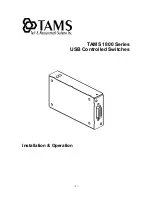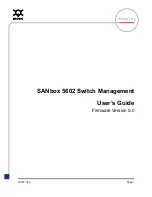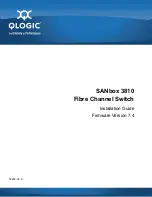
4
L
OGGING
IN
THROUGH
T
ELNET
Introduction
You can manage and maintain a switch remotely by Telneting to the switch. To
achieve this, you need to configure both the switch and the Telnet terminal
accordingly.
Common Configuration
Table 21 lists the common Telnet configuration.
Table 20
Requirements for Telnet to a switch
Item Requirement
Switch
The IP address of the VLAN interface of the switch is configured and
the route between the switch and the Telnet terminal is available.
(Refer to “Configuring an IP Address for a VLAN Interface” on page
129 for more.)
The authentication mode and other settings are configured. Refer to
Table 21 and Table 22.
Telnet terminal
Telnet is running.
The VLAN IP address of the switch is available.
Table 21
Common Telnet configuration
Configuration
Description
VTY user
interface
configuration
Configure the command
level available to users
logging into the VTY user
interface
Optional
By default, commands of level 0 are available
to users logging into a VTY user interface.
Configure the protocols the
user interface supports
Optional
By default, Telnet and SSH protocol are
supported.
VTY terminal
configuration
Make terminal services
available
Optional
By default, terminal services are available in all
user interfaces
Set the maximum number of
lines the screen can contain
Optional
By default, the screen can contain up to 24
lines.
Set history command buffer
size
Optional
By default, the history command buffer can
contain up to 10 commands.
Set the timeout time of a
user interface
Optional
The default timeout time is 10 minutes.
Set whether to display the
copyright statement
information
Optional
By default, the copyright information is
displayed when a user logs into a switch
through Telnet.
Summary of Contents for Switch 7757
Page 32: ...32 CHAPTER 1 CLI OVERVIEW...
Page 70: ...70 CHAPTER 5 LOGGING IN USING MODEM...
Page 76: ...76 CHAPTER 7 LOGGING IN THROUGH NMS...
Page 86: ...86 CHAPTER 9 CONFIGURATION FILE MANAGEMENT...
Page 120: ...120 CHAPTER 13 ISOLATE USER VLAN CONFIGURATION...
Page 126: ...126 CHAPTER 14 SUPER VLAN...
Page 136: ...136 CHAPTER 16 IP PERFORMANCE CONFIGURATION...
Page 152: ...152 CHAPTER 17 IPX CONFIGURATION...
Page 164: ...164 CHAPTER 19 QINQ CONFIGURATION...
Page 172: ...172 CHAPTER 21 SHARED VLAN CONFIGURATION...
Page 182: ...182 CHAPTER 22 PORT BASIC CONFIGURATION...
Page 198: ...198 CHAPTER 24 PORT ISOLATION CONFIGURATION...
Page 208: ...208 CHAPTER 25 PORT SECURITY CONFIGURATION...
Page 224: ...224 CHAPTER 27 DLDP CONFIGURATION...
Page 232: ...232 CHAPTER 28 MAC ADDRESS TABLE MANAGEMENT...
Page 240: ...240 CHAPTER 29 CENTRALIZED MAC ADDRESS AUTHENTICATION CONFIGURATION...
Page 280: ...280 CHAPTER 30 MSTP CONFIGURATION...
Page 348: ...348 CHAPTER 35 IS IS CONFIGURATION...
Page 408: ...408 CHAPTER 39 802 1X CONFIGURATION...
Page 412: ...412 CHAPTER 40 HABP CONFIGURATION...
Page 422: ...422 CHAPTER 41 MULTICAST OVERVIEW...
Page 426: ...426 CHAPTER 42 GMRP CONFIGURATION...
Page 480: ...480 CHAPTER 47 PIM CONFIGURATION...
Page 506: ...506 CHAPTER 48 MSDP CONFIGURATION...
Page 552: ...552 CHAPTER 51 TRAFFIC ACCOUNTING CONFIGURATION...
Page 570: ...570 CHAPTER 53 HA CONFIGURATION...
Page 582: ...582 CHAPTER 54 ARP CONFIGURATION SwitchA arp protective down recover interval 200...
Page 622: ...622 CHAPTER 58 DHCP RELAY AGENT CONFIGURATION...
Page 684: ...684 CHAPTER 61 QOS CONFIGURATION...
Page 718: ...718 CHAPTER 63 CLUSTER...
Page 738: ...738 CHAPTER 67 UDP HELPER CONFIGURATION...
Page 752: ...752 CHAPTER 69 RMON CONFIGURATION...
Page 772: ...772 CHAPTER 70 NTP CONFIGURATION...
Page 796: ...796 CHAPTER 72 FILE SYSTEM MANAGEMENT...
Page 802: ...802 CHAPTER 73 BIMS CONFIGURATION...
Page 814: ...814 CHAPTER 74 FTP AND TFTP CONFIGURATION...
Page 830: ...830 CHAPTER 75 INFORMATION CENTER...
Page 836: ...836 CHAPTER 76 DNS CONFIGURATION...
Page 852: ...852 CHAPTER 77 BOOTROM AND HOST SOFTWARE LOADING...
Page 858: ...858 CHAPTER 78 BASIC SYSTEM CONFIGURATION DEBUGGING...
















































